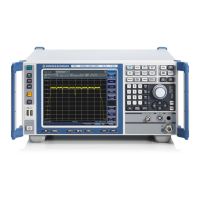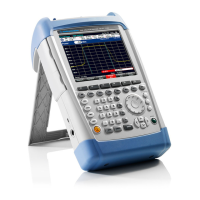Instrument Functions
R&S
®
FSVA/FSV
534Operating Manual 1176.7510.02 ─ 09
Remote command:
[SENSe:]MIXer:SIGNal on page 829
Auto ID (On/Off) ← External Mixer
Activates or deactivates automatic signal identification.
Auto ID basically functions like Signal ID (On/Off). However, the test and reference
sweeps are converted into a single trace by a comparison of maximum peak values of
each sweep point. The result of this comparison is displayed in trace 3 if "Signal ID" is
active at the same time. If "Signal ID" is not active, the result can be displayed in any of
the traces 1 to 3. Unwanted mixer products are suppressed in this calculated trace.
(See also Chapter 3.8.1.5, "Remarks on Signal Identification with Auto ID",
on page 521).
Real input signals are displayed at the same frequency in the test and reference
sweeps, i.e. theoretically identical signal levels are expected in the two sweeps at the
frequency of the real mixer product. If the level difference is lower than the tolerance
set with Auto ID Threshold, the signal obtained in the test sweep is displayed. If a sig-
nal occurs only in the test sweep or reference sweep, it is an unwanted mixer product.
The level of this signal is compared to the noise floor in the other sweep. If the S/N
ratio is sufficiently large, the tolerance limit for the maximum permissible level differ-
ence is exceeded. This means that the signal with the lower level, i.e. noise in this
case, is displayed.
Note that "Auto ID" functions according to the fail-safe principle, i.e. unwanted mixer
products may not be detected as such but signals which are in fact real input signals
are not blanked out. See also Chapter 3.8.1.5, "Remarks on Signal Identification with
Auto ID", on page 521.
Remote command:
[SENSe:]MIXer:SIGNal on page 829
Instrument Functions – External Mixer (Option R&S
FSV-B21)

